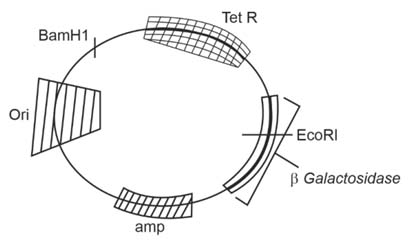Topic Question Set
Q 31
:
Which of the following restriction enzymes produces blunt ends? [2016]
SalI
EcoRV
XhoI
Hind III
(2)
EcoRV is a type II restriction endonuclease isolated from certain strains of E. coli. It creates blunt ends. It recognises the palindromic sequence of 6 bases. SalI, XhoI and Hind III restriction enzymes produce sticky ends.
Q 32
:
Which of the following is not a feature of the plasmids? [2016]
Transferable
Single-stranded
Independent replication
Circular structure
(2)
Plasmids are extra-chromosomal, self-replicating, usually circular, double-stranded DNA molecules that serve as vectors which carry foreign DNA segment and replicate inside host cell.
Q 33
:
Which of the following is a restriction endonuclease? [2016]
DNase I
RNase
Hind II
Protease
(3)
Hind II is the first restriction endonuclease. It was isolated from Haemophilus influenzae Rd. It always cuts DNA at specific position producing blunt ends. DNase I is an endonuclease that cleaves DNA preferentially at phosphodiester linkages adjacent to a pyrimidine nucleotide. RNase is a type of nuclease that catalyses the degradation of RNA into smaller components. It can be endoribonuclease or exoribonuclease. A protease is an enzyme that performs proteolysis, i.e., protein catabolism by hydrolysis of the peptide bonds.
Q 34
:
The introduction of T-DNA into plants involves [2015]
exposing the plants to cold for a brief period
allowing the plant roots to stand in water
infection of the plant by Agrobacterium tumefaciens
altering the pH of the soil, then heat-shocking the plants.
(3)
Ti plasmid (tumor inducing) from the soil bacterium Agrobacterium tumefaciens is effectively used as vector for gene transfer to plant cells. The part of Ti plasmid transferred into plant cell DNA, is called the T-DNA. This T-DNA with desired DNA spliced into it, is inserted into the chromosomes of the host plant where it produces copies of itself. Such plant cells are then cultured, induced to multiply and differentiate to form plantlets. By transferring into soil, the plantlets grow into mature plants, carrying the foreign gene, expressed throughout the new plant.
Q 35
:
Which vector can clone only a small fragment of DNA? [2014]
Bacterial artificial chromosome
Yeast artificial chromosome
Plasmid
Cosmid
(3)
Plasmids have been modified to be used as vectors. They can clone DNA fragments of about 10 kbp size while cosmid can carry upto 45 kbp, YAC can carry upto 1000–2500 kbp and BAC can carry around 300–350 Kbp long DNA fragments.
Q 36
:
Commonly used vectors for human genome sequencing are [2014]
T - DNA
BAC and YAC
expression vectors
T/A cloning vectors
(2)
Bacterial artificial chromosome (BAC) vectors are based on natural, extra-chromosomal plasmid of E. coli. BAC vector contains genes for replication and maintenance of the F-factor, a selectable marker and cloning site. These vectors can accommodate upto 300–350 kb of foreign DNA and are also being used in genome sequencing project. Yeast artificial chromosome (YAC) vectors are used to clone DNA fragments of more than 1Mb in size. Therefore, they have been exploited extensively in mapping the large genomes, e.g., in the Human Genome Project. These vectors contain the telomeric sequence, the centromere and the autonomously replicating sequence from yeast chromosomes.
Q 37
:

In the above represented plasmid, an alien piece of DNA is inserted at EcoRI site. Which of the following strategies will be chosen to select the recombinant colonies? [2025]

Using ampicillin & tetracycline containing medium plate.
Blue color colonies will be selected.
White color colonies will be selected.
Blue color colonies grown on ampicillin plates can be selected.
(3)
The correct answer is that white-colored colonies will be selected.
Since an alien piece of DNA is being inserted at EcoRI site, the gene -galactosidase present here will undergo insertional inactivation.
This gene is responsible for producing blue-colored colonies, but since it has been insertionally inactivated, white colored colonies will be produced.
Ampicillin and tetracycline resistance genes present in the given DNA will remain intact. Thus, the given DNA will show and .
Q 38
:
Given below are two statements : [2025]
Statement I : The DNA fragments extracted from gel electrophoresis can be used in construction of recombinant DNA.
Statement II : Smaller size DNA fragments are observed near anode while larger fragments are found near the wells in an agarose gel.
In the light of the above statements, choose the most appropriate answer from the options given below :
Both statement I and statement II are correct
Both statement I and statement II are incorrect
Statement I is correct but statement II is incorrect
Statement I is incorrect but statement II is correct
(1)
The cutting of DNA by restriction endonucleases results in the fragments of DNA. These fragments can be separated by a technique known as gel electrophoresis.
The separated bands of DNA are cut out from the agarose gel and extracted from the gel piece. This step is known as elution. The DNA fragments purified in this way are used in constructing rDNA by joining them with cloning vectors.
• In gel electrophoresis, the DNA fragments separate (resolve) according to their size through sieving effect provided by the agarose gel. Hence, the smaller the fragment size, the farther it moves from cathode towards anode.
Q 39
:
Which of the following enzyme(s) are NOT essential for gene cloning? [2025]
A. Restriction enzymes
B. DNA ligase
C. DNA mutase
D. DNA recombinase
E. DNA polymerase
Choose the correct answer from the options given below:
C and D only
A and B only
D and E only
B and C only
(1)
Gene cloning is a process where a specific gene or DNA sequence is isolated and replicated, creating multiple identical copies.
In gene cloning, restriction enzymes, DNA ligase and DNA polymerase are primarily used.
Q 40
:
The blue and white selectable markers have been developed which differentiate recombinant colonies from nonrecombinant colonies on the basis of their ability to produce colour in the presence of a chromogenic substrate.
Given below are two statements about this method:
Statement I : The blue coloured colonies have DNA insert in the plasmid and they are identified as recombinant colonies.
Statement II : The colonies without blue colour have DNA insert in the plasmid and are identified as recombinant colonies.
In the light of the above statements, choose the most appropriate answer from the options given below: [2025]
Both Statement I and Statement II are correct
Both Statement I and Statement II are incorrect
Statement I is correct but Statement II is incorrect
Statement I is incorrect but Statement II is correct
(4)
Statement I is incorrect but statement II is correct as a recombinant DNA is inserted within the coding sequence of an enzyme, -galactosidase. This results into inactivation of the gene for synthesis of this enzyme. Thus, presence of insert results into insertional inactivation of the -galactosidase gene and the colonies do not produce any colour and identified as recombinant colonies. Whereas non-recombinant transformants will produce blue colour in presence of chromogenic substrate.

